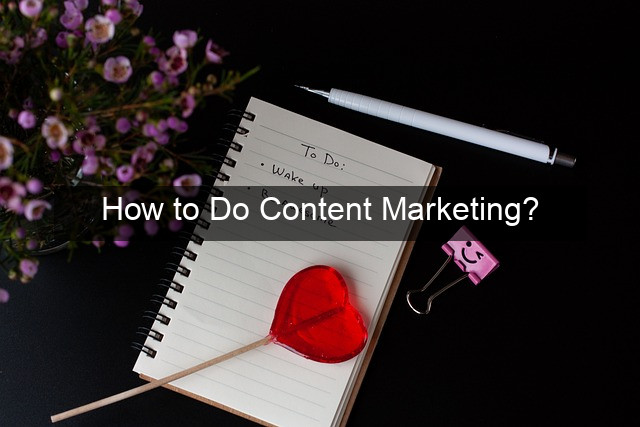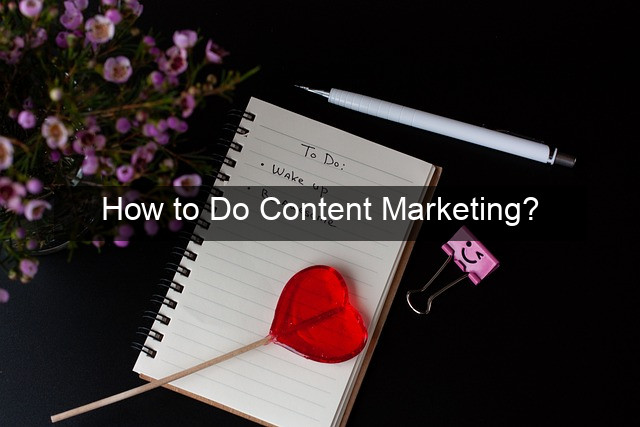How to Do Content Marketing?

- How to Do Content Marketing?
- How to Do Content Marketing Effectively
- Developing Your Content Strategy
- Understanding Your Target Audience
- Setting Clear Goals and Objectives
- Keyword Research and Topic Selection
- Creating Engaging Content
- Crafting Compelling Headlines
- Writing High-Quality Content
- Incorporating Visuals
- Promoting and Distributing Your Content
- Social Media Marketing
- Email Marketing
- Content Repurposing
- Analyzing and Optimizing Your Content
- Tracking Key Metrics

How to Do Content Marketing Effectively
In today’s digital landscape, content marketing reigns supreme. It’s the engine that drives engagement, builds brand loyalty, and ultimately, boosts your bottom line. But simply churning out content isn’t enough. You need a strategic approach, a well-defined plan, and a deep understanding of your audience to truly harness the power of content marketing. This comprehensive guide will equip you with the knowledge and tools you need to create a successful content marketing strategy, from crafting compelling content to measuring your results and adapting your approach.
Content marketing is more than just writing blog posts; it’s about creating valuable, relevant, and consistent content that attracts and retains a clearly defined audience — and, ultimately, to drive profitable customer action. It’s about building relationships, fostering trust, and establishing your brand as a thought leader in your industry. This guide will delve into the essential elements of a thriving content marketing strategy, providing actionable insights and practical tips to help you achieve your marketing goals. Whether you’re a seasoned marketer or just starting out, this guide will provide you with a roadmap to success.
Developing Your Content Strategy
Understanding Your Target Audience
The cornerstone of any successful content marketing strategy is a deep understanding of your target audience. Who are they? What are their pain points? What are their interests and aspirations? By answering these questions, you can tailor your content to resonate with their needs and provide genuine value. This understanding allows you to create content that addresses their specific challenges and provides solutions, ultimately building trust and establishing your brand as a go-to resource.
Conduct thorough research to identify your ideal customer. Utilize tools like surveys, social media analytics, and market research reports to gather data on demographics, psychographics, and online behavior. This information will inform your content creation process and ensure that your message reaches the right people.
Once you have a clear picture of your audience, create detailed buyer personas. These semi-fictional representations of your ideal customers should include information about their demographics, professional background, goals, challenges, and preferred content formats. Refer to these personas regularly to ensure your content remains aligned with your target audience’s needs.
Setting Clear Goals and Objectives
Before diving into content creation, define your content marketing goals. What do you hope to achieve with your content? Whether it’s increasing brand awareness, driving website traffic, generating leads, or boosting sales, clearly defined goals will guide your efforts and allow you to measure your success. Setting measurable goals is crucial for tracking progress and demonstrating the return on investment (ROI) of your content marketing efforts.
Establish Key Performance Indicators (KPIs) to track your progress towards your goals. These metrics should be specific, measurable, achievable, relevant, and time-bound (SMART). Common KPIs include website traffic, lead generation, social media engagement, and conversion rates. Regularly monitor these KPIs to assess the effectiveness of your content and make necessary adjustments.
Align your content marketing goals with your overall business objectives. Ensure that your content strategy contributes to the larger picture and supports the growth of your business. This alignment will ensure that your content marketing efforts are not siloed but integrated into your overall marketing strategy.
Keyword Research and Topic Selection
Effective keyword research is essential for optimizing your content for search engines. Identify relevant keywords that your target audience is searching for. Use keyword research tools to discover high-volume, low-competition keywords that you can incorporate into your content naturally. This will improve your search engine rankings and drive organic traffic to your website.
Once you have a list of target keywords, brainstorm content topics that align with those keywords and address your audience’s needs. Focus on creating valuable, informative, and engaging content that provides solutions to their problems or answers their questions. This will establish your brand as a trusted resource and encourage repeat visits.
Develop a content calendar to organize your content creation efforts. Plan out your topics in advance and schedule publishing dates to maintain a consistent flow of content. This will help you stay organized and ensure that you are consistently providing valuable content to your audience.
Creating Engaging Content
Crafting Compelling Headlines
Your headline is the first impression your content makes. It needs to be compelling enough to grab attention and entice readers to click through and read more. Craft headlines that are clear, concise, and benefit-driven, highlighting the value that readers will gain from consuming your content.
Experiment with different headline formats, such as questions, how-to guides, and listicles, to see what resonates best with your audience. Use strong action verbs and power words to create a sense of urgency and excitement. A well-crafted headline can significantly impact your click-through rates and overall content performance.
Optimize your headlines for search engines by incorporating relevant keywords. However, prioritize clarity and readability over keyword stuffing. Ensure that your headlines accurately reflect the content of your article and avoid misleading or clickbait-y tactics.
Writing High-Quality Content
The heart of content marketing is high-quality content. Focus on providing valuable, informative, and engaging content that resonates with your target audience. Address their pain points, answer their questions, and provide solutions to their problems. This will establish your brand as a trusted resource and encourage repeat visits.
Use clear, concise language and avoid jargon. Break up your text with headings, subheadings, bullet points, and visuals to make it easier to read and digest. Incorporate storytelling techniques to connect with your audience on an emotional level and make your content more memorable.
Optimize your content for search engines by incorporating relevant keywords naturally. Use internal and external links to provide additional context and resources for your readers. Ensure your content is mobile-friendly and loads quickly to provide a positive user experience.
Incorporating Visuals
Visuals play a crucial role in engaging your audience and enhancing the readability of your content. Incorporate images, videos, infographics, and other visual elements to break up large blocks of text and make your content more visually appealing.
Use high-quality images and videos that are relevant to your content. Optimize your visuals for web performance to ensure they load quickly and don’t slow down your website. Add alt text to your images to improve accessibility and SEO.
Choose visuals that complement your written content and enhance its message. Use visuals to illustrate complex concepts, provide data visualizations, or add a touch of humor to your content. Visuals can significantly increase engagement and make your content more shareable.
Promoting and Distributing Your Content
Social Media Marketing
Social media is a powerful tool for promoting your content and reaching a wider audience. Share your content across your social media channels and engage with your followers. Tailor your message to each platform and use relevant hashtags to increase visibility.
Run social media contests and giveaways to generate excitement and encourage sharing. Use social media analytics to track your performance and identify what type of content resonates best with your audience. Engage with your followers by responding to comments and messages.
Build relationships with influencers in your industry and collaborate on content creation and promotion. Influencer marketing can be a highly effective way to reach a new audience and build credibility.
Email Marketing
Email marketing is a valuable tool for nurturing leads and building relationships with your audience. Use email newsletters to share your latest content, promote upcoming events, and offer exclusive deals. Segment your email list to personalize your messages and target specific audience segments.
Use compelling subject lines to encourage opens and personalize your emails to build rapport with your subscribers. Provide clear calls to action in your emails and track your email marketing metrics to measure your success.
Offer valuable incentives, such as free ebooks or webinars, to encourage sign-ups to your email list. Ensure that your emails are mobile-friendly and comply with data privacy regulations.
Content Repurposing
Maximize the reach of your content by repurposing it into different formats. Turn blog posts into infographics, videos, or podcasts. Share snippets of your content on social media and create presentations from your research data. Repurposing content allows you to reach a wider audience and extend the lifespan of your existing content.

Identify which pieces of content are performing well and consider repurposing them into different formats. This can save you time and resources while maximizing the impact of your content marketing efforts. Repurposing content also allows you to cater to different learning styles and preferences.
When repurposing content, ensure that you adapt the format and messaging to suit the specific platform or channel. For example, a blog post may need to be condensed and visually enhanced for social media, while a webinar may require a more in-depth and interactive approach.
Analyzing and Optimizing Your Content
Tracking Key Metrics
Regularly track



